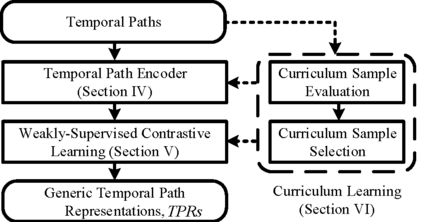In step with the digitalization of transportation, we are witnessing a growing range of path-based smart-city applications, e.g., travel-time estimation and travel path ranking. A temporal path(TP) that includes temporal information, e.g., departure time, into the path is fundamental to enable such applications. In this setting, it is essential to learn generic temporal path representations(TPRs) that consider spatial and temporal correlations simultaneously and that can be used in different applications, i.e., downstream tasks. Existing methods fail to achieve the goal since (i) supervised methods require large amounts of task-specific labels when training and thus fail to generalize the obtained TPRs to other tasks; (ii) through unsupervised methods can learn generic representations, they disregard the temporal aspect, leading to sub-optimal results. To contend with the limitations of existing solutions, we propose a Weakly-Supervised Contrastive (WSC) learning model. We first propose a temporal path encoder that encodes both the spatial and temporal information of a temporal path into a TPR. To train the encoder, we introduce weak labels that are easy and inexpensive to obtain and are relevant to different tasks, e.g., temporal labels indicating peak vs. off-peak hours from departure times. Based on the weak labels, we construct meaningful positive and negative temporal path samples by considering both spatial and temporal information, which facilities training the encoder using contrastive learning by pulling closer to the positive samples' representations while pushing away the negative samples' representations. To better guide contrastive learning, we propose a learning strategy based on Curriculum Learning such that the learning performs from easy to hard training instances. Experiments studies verify the effectiveness of the proposed method.
翻译:随着运输的数字化,我们正在目睹越来越多的基于路径的智能城市应用,例如,旅行时间估计和旅行路径排名。一个时间路径(TP),包括时间信息,例如离开时间,进入路径,对于使这些应用成为根本。在这一背景下,必须学习通用的时间路径表达方式(TPRs),既考虑空间和时间相关性,又可用于不同的应用,即下游任务。现有方法未能实现目标,因为(一) 监管方法需要大量特定任务标签,在培训时,无法将所获得的 TPR 推广到其他任务; (二) 通过不受监督的方法,可以学习通用的表达方式,例如离开时间,进入路径是根本的。为了与现有解决方案的局限性相对,我们建议一种双向积极的超时路路路路,即下游任务。我们首先建议一种将时间路径的时空信息编码为时间路径,然后将所获得的时间路径转换为 TRP 逻辑( ) ( ), 使用简单路径校正路路, 将我们学习到更精确的路径, 学习到更精确的路径 。
















